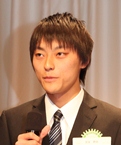��Rotaract Week�� Meeting
��ROTEX and the Rotary Youth Exchange Program��
March 9, 2011
Mr. Mikiya Miyanaga
Chairman, ROTEX(District 2580)
 ��Today, let me speak on the objectives and mission of ROTEX and its core activity, the Rotary Youth Exchange Program. This is because not much is known on ROTEX and some people mix it up with Rotaract.
��Today, let me speak on the objectives and mission of ROTEX and its core activity, the Rotary Youth Exchange Program. This is because not much is known on ROTEX and some people mix it up with Rotaract.
����Mutual Understanding and Peace�� as well as ��Goodwill Ambassador for Peace�� are the two key phrases of this Youth Exchange Program. Building mutual understanding with people from different countries and cultures is the most effective way to promote world peace. This program gives opportunities to many young people to plant the seeds for a lifetime of international understanding. It also brings numerous benefits to host Rotarians and mentors, as well as to the community at large. Students learn firsthand about all aspects of life in another country. As they expand their horizon, they deepen understanding of themselves, too.
��This program fosters local high school students and exchange students, who will in the future become goodwill ambassadors for peace in many parts of the world. I believe this program best embodies this year��s RI slogan, ��BUILDING COMMUNITIES BRIDGING CONTINENTS.��
��Today, more than 8,000 Youth Exchange students study in over 200 countries a year, including 300 Japanese students. I believe the small circles of mutual understanding will spread out to promote world peace. It is so disappointing that the number of Japanese exchanging students has decreased in recent years.
��Now, what makes the Rotary exchange program different from other study-abroad programs? The biggest difference is that Rotary program is not merely about learning a foreign language, but aims at fostering ��goodwill ambassadors for peace�� to promote world peace. Japanese high school students attain maturity as they go abroad, making new friends, meeting many families, encountering different cultures and then acquire an objective view on Japan. Another difference is that the students go through the one-year orientation before leaving Japan, to deepen understanding on Rotary activities and Japanese culture. For example, in District 2580, students to be sent abroad in August start their orientation from May the previous year.
��Youth exchange students must abide by the ��4D rules: No Drugs, No Drinking, No Driving and No Dating.�� Some countries have the additional ��No Decorating (tattoo, body piercing etc.)�� rule. Should a student break one rule, he/she will be sent back home immediately.
��ROTEX is in charge of assisting this Youth Exchange Program. It is a group of Youth Exchange alumni, who volunteer to serve for the term of 3 years. Its objectives are: 1. Support inbound students studying in Japan, 2. Help improve the orientation program for outbound students, and 3. Give advices to students who are currently studying abroad. We also have various events to promote interaction among inbound and outbound students, so that students have an experience of communicating with foreigners without using Japanese before they actually go abroad. Japanese high school students experience various problems as they live and study in different countries. As ROTEX members had gone through the same experiences, they are in the best position to give personal advices and information based on their actual experience.
��Now, let me touch upon the structure of ROTEX. There are the following four sections under the supervision of the Chairman and Vice-Chairman: 1. Tea Minister (organize the tea ceremony party twice a month), 2. Junior Counselors for Inbound Students, 3. Outbound Student Assistance, and 4. Treasurer.
����Peace begins with Smiles�� is this year��s ROTEX slogan. We can never achieve peace unless students, who are goodwill ambassadors for peace, keep smiling. Making them smile leads to world peace.
��Activities of ROTEX start with the arrival of inbound students at Narita Airport in August. They will go through an intensive two-week training on Japanese in mid-August, before assigned to each host family. Various events are organized throughout the year, including the 8 orientation sessions for outbound students. Tea ceremony lessons start from September, to deepen understanding of Japanese culture. We also arrange a tour to various places around Japan in March to deepen firsthand experiences. The annual events conclude with the Debriefing Session in June, where inbound students summarize their achievements in a 7-minute speech before returning to their home countries. We are often amazed and impressed by their fluency in Japanese.
��One student said ��every single day was an adventure for me in Japan.�� Everyday life was a new discovery for this student. As we listen to their speeches, we realize, anew, the significance of this program and wish for its further development in the future.
��We are grateful to the members of the Youth Exchange Committee, as their confidence entrusted upon us allows our free activity. We are determined to continue doing our best to base our activities on trust built by our senior ROTEX members. Let me conclude by asking for your further understanding and cooperation.